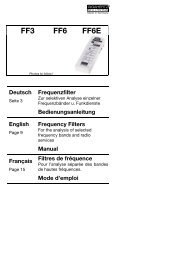HF-Analyser - Gigahertz Solutions
HF-Analyser - Gigahertz Solutions
HF-Analyser - Gigahertz Solutions
You also want an ePaper? Increase the reach of your titles
YUMPU automatically turns print PDFs into web optimized ePapers that Google loves.
Made in Germany<br />
To be on the safe side in this comparison you may multiply the<br />
measurement by 4 and use the result as base value for the comparison.<br />
This is often done to make safe recommendations even<br />
in case of readings on the low side despite still being within the<br />
tolerance band. One has to consider, however, that this may also<br />
lead to higher values than actually existent.<br />
The ratio of minimum to maximum load of a cellular phone base<br />
station usually is 1 to 4. At the time of measurement one does not<br />
know the exact load. One way to overcome this is to measure<br />
during low load periods (in the very early morning hours, e.g. from<br />
3 to 5 am) and muliply the measurement by 4.<br />
Special case: UMTS/3G and DVB-T: Measure 1 to 2 minutes 7 in<br />
their incoming direction tilting the instrument slightly around it.<br />
These special types of signals can sometimes be undervalued by<br />
a factor of 5 by the analysers described here.<br />
Special case: Radar for aviation and navigation. Radar beams are<br />
emitted by slowly rotating antennas. Therefore they are only<br />
measurable and “audio-analysed” every few seconds for milliseconds.<br />
This necessitates a special approach:<br />
Set ”Signal“ to ”peak“. After a couple of radar beam passes<br />
read out the highest number displayed. Because of the slow<br />
repetition rate of the display necessary for all other measurements,<br />
the numbers will vary considerably and will only be displayed<br />
for a very short period of time. When using the <strong>HF</strong>38B<br />
set the switch to ”Peak-hold“ and allow for several beam passes<br />
to establish the equilibrium of charging and drooping, which<br />
may take a few minutes.<br />
<br />
Peak hold<br />
Radar<br />
© <strong>Gigahertz</strong> <strong>Solutions</strong> GmbH 11<br />
Peak<br />
Symbolic sketch<br />
In most cases the measurement will be at the lower tolerance<br />
band or in the extreme case even up to a factor of 10 too low 8<br />
.<br />
For a simplified measurement of UMTS/3G-, DVB-T and Radar<br />
without correction factors, <strong>Gigahertz</strong> <strong>Solutions</strong> offers the professional<br />
<strong>HF</strong>-<strong>Analyser</strong>s <strong>HF</strong>58B-r and <strong>HF</strong>59B.<br />
Limiting values, recommendations and<br />
precautions<br />
The ”Standard der baubiologischen Messtechnik“ (Standard for<br />
Building Biology Measurements), SBM 2008, classifies measurements<br />
(per radio communication service), with a note of caution<br />
”pulsed signals to be taken more seriously than continuous ones“,<br />
as follows:<br />
Building Biology Recommendations as per SBM-2008<br />
7<br />
Measurement will take longer because of the rapid fluctuations typical especially<br />
for UMTS.<br />
8<br />
Please note that there are also Radar systems operating in the higher <strong>Gigahertz</strong><br />
range.



